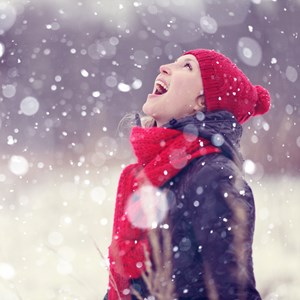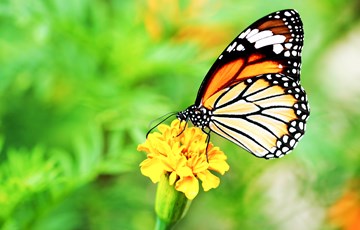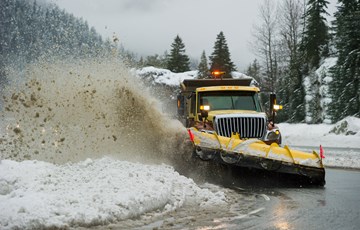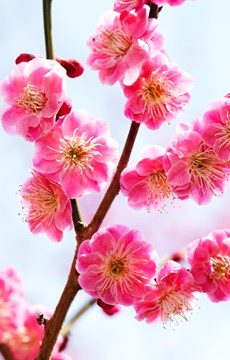Who else is enjoying the winter already?  i'm sure most of you would be.... but have you heard these things about winter before?
i'm sure most of you would be.... but have you heard these things about winter before? 
To know the answer,
Let's read & See!

To know the answer,
Let's read & See!

- Winter cold kills more than twice as many Americans as summer heat does.
- In one study, men rated pictures of women’s breasts and bodies as more attractive in the winter months, while they rated pictures of women’s faces the same. Researchers believe men don’t see women’s bodies as much during the winter, so they’re more excited when they do.
- The Southern Hemisphere typically has milder winters than the Northern Hemisphere. This is because the Southern Hemisphere has less land and a more maritime climate.
- While it seems counter intuitive, Earth is actually closest to the sun in December, even though winter solstice is the shortest day of the year.
- According to the Guinness World Records, on January 28, 1887, a snowflake 15 inches wide and 8 inches thick fell in Fort Keogh, Montana, making it the largest snowflake ever observed.
- Chionophobia is the persistent fear of snow, especially becoming trapped by snow. The term is derived from the Greek words chion and phobos, meaning “snow” and “fear,” respectively.
- Snowflakes are actually translucent, not white
- Every winter, at least one septillion (that’s 1 followed by 24 zeros) snow crystals fall from the sky.[4]
- A New Zealand insect called the Weta freezes completely solid when temperatures drop during the winter. However, when temperatures warm back up, the insect unfreezes, thaws, and resumes its activities.
- Google searches for terms like “porn,” “boobs,” “xxx,” and “massage parlor” have a 6-month seasonal pattern. Specifically, they peak in early summer and around the winter holidays. Google searches for “eHarmony” and “Match.com” also peaked around these times.
- The onset of menopause is significantly higher in winter than in spring or autumn, with a smaller peak in summer.
- The average snowflake falls at about 3 mph.
- One inch of snow will produce just less than 1/10 of an inch of water when melted. Ten inches of snow will melt down to only 1 inch of water.
- The largest recorded snowman ever built was in Bethel, Maine, in February 1999. The 113-foot, 7-inch snowman broke the previous record held by Yamagata, Japan, at 96 feet and 7 inches.
- Bismarck, North Dakota, holds the record for the most snow angels at one time. On February 17, 2007, several schools joined forces to create 8,962 snow angels.
- Even today, the Kwakiutl Indians of British Columbia change their names and take on the names of their ancestors at the beginning of winter. They believe this will protect them from the spirits of the dead who return at this time of year.
- While the winter solstice is the shortest day of the year, seasonal lag means that the coldest period usually follows the solstice by a few weeks.
- A woman needs her lucky socks
- Cold winter weather dulls sexual sensations, and cooler body temperatures decrease arousal for both men and women. Interestingly, women are 30% more likely to orgasm if their feet are warm.
- A single snowstorm can drop 39 million tons of snow.
- Snow appears white because snow is a bunch of individual ice crystals arranged together. When light hits snow, it bounces all around the ice crystals and the “color” of all the frequencies in the visible spectrum combined in equal measure is white. While white is the color we see in snow, individual ice crystals are actually translucent.
- The most snow ever recorded in 24 hours in the United States was at Silver Lake, Colorado, in 1921 at 76 inches. Coming in second is Georgetown, Colorado, in December 4, 1913, at 63 inches.
- Mt. Baker ski area in Washington state holds the world record for snowfall at 1,140 inches of snow during the 1998–1999 winter season.
- From 2006–2010, about 2,000 U.S. residents died each year from weather-related causes. About 63% of these deaths were in the winter, while about 31% were in the summer. Only about 6% were attributed to floods, severe storms, tornadoes, hurricanes, or lightening. These statistics do not include weather-related traffic accidents, which kill more than 7,000 Americans each year.
- The worst death toll in the United States for a winter storm occurred in The Great Blizzard of 1888 in the Northeast. Over March 11–14, the blizzard dropped between 40–50 inches of snow in parts of New York, New Jersey, Connecticut, and Massachusetts. It blocked roads and wiped out telephone, telegraph, and rail service for days. It was responsible for over 400 deaths (200 in New York alone) and sank 200 ships. New York and Boston created the first underground subway system partly in response to the massive 1888 storm and the gridlock it created.
- The first Winter Olympics were held in Chamonix, France, in 1924. No country in the Southern Hemisphere has hosted, or even been an applicant to host, the Winter Olympics.
- Monarchs can travel between 50 to 100 miles a day
- Millions of monarch butterflies fly to Mexico for the winter. They are the only insect that migrates to a warmer climate that is 2,500 miles away each year. Additionally, they like to hibernate in the same trees every year.
- Known as “The Storm of the Century,” a blizzard and a cyclone swept destruction from Cuba to Canada on March 12, 1993, a week before spring. The storm was responsible for 310 deaths and $6.6 billion in damage, and it shut down the southern part of the U.S. for three days.
- Around 12% of Earth’s land surface is covered in snow and ice.
- The Children’s Blizzard ravaged the U.S. Great Plains states on January 12, 1888. The unexpected blizzard approached suddenly on an otherwise warm day, catching many people, including many school children, unaware. The death toll was 235 people, of which 213 were children.
- The Armistice Day Blizzard exploded over the Midwest on November 11, 1940, when cold northern air collided with warm Gulf Coast moisture. The blizzard created 20-foot snowdrifts and was responsible for 145 deaths, including 25 duck hunters who were not prepared for the sudden cold.
- President Barack Obama popularized the phrase “Snowmagddon” when two blizzards in 2010 struck during the Democratic National Committee’s winter meeting. The blizzards broke snowfall records in the mid-Atlantic region, and after the second snowstorm, 68.1% of the U.S. was blanketed by snow.
- Winter in the Northern and Southern Hemispheres is caused by Earth’s axis in that hemisphere being tilted away from the sun.
- Meteorologists often define winter as the three calendar months with the lowest average temperatures. For the Northern Hemisphere, this is December, January, and February. For the Southern Hemisphere, it is June, July, and August.
- The coldest temperature ever recorded was -123° C at Vostok Station in Antarctica in 1983.
- Many insects prepare for winter by creating their own “antifreeze.” During the fall, insects produce more glycerol, which gives their body a “super-cooling ability” by allowing bodily fluids to drop below freezing without causing ice damage. Glycerol also lowers the freezing point, which makes insects more cold tolerant and protects their tissue and cells from ice damage. Their glycerol levels drop again during the spring.
- The definition of a blizzard is when visibility is reduced to ¼ of a mile and the winds are 35 mph or more. The storm also must last at least 3 hours. If any of these specific conditions is not met, then it is a snowstorm instead.
- There is an average of 105 snow-producing storms in the United States in a typical year. An average storm will last 2–5 days and carry snow to several states.
- All snowflakes have 6 sides
- Thanks to hydrogen bonding, all snowflakes have six sides
- The coldest winter on Earth occurs at the Polar Plateau in Antarctica. The average mean annual temperature is -72.9° Fahrenheit.
- Winters in Russia are so harsh that they are a natural defense during war. For example, rather than entering into peace negotiations with Napoleon Bonaparte, Tsar Alexander I decided to let Russia’s cold winter deal with the French invaders.
- In 1974, Russia hit -96° Fahrenheit in Siberia during winter, making Russia the coldest country in the world. Canada, Mongolia, Finland, and Iceland round out the top five.
- Most weather-related crashes in the U.S. happen on wet pavement and during rainfall. Specifically, 74% occur on wet pavement and 46% during rainfall. About 17% occur during snow or sleet, 12% on icy pavement, and 14% take place on snowy or slushy pavement. Only 3% happen in the presence of fog.
- To survive winters, many animals have developed various survival techniques, such as migrating, hibernating, storing food, changing colors, or growing thicker fur.
- Winter cold increases a person’s appetite—which can, in turn, lower libido. Unfortunately, weight gain decreases libido and makes both men and women less sexually adventurous.
- Couples are more than twice as likely to think about splitting up between the year-end holidays and Valentine’s Day. The two major reasons are that 1) the holidays are stressful and 2) energy levels are lower during cold weather and people tend to be moodier.
- In the U.S., over 116,000 people are injured and over 1,300 are killed on snowy, slushy or icy pavement every winter
- Winter road maintenance accounts for approximately 20% of state DOT maintenance each year. Each year, state and local agencies spend over $2.3 billion on snow- and ice-control operations.
- The most common birthday in the United States is September 16th, which means that most babies are conceived during the early winter holiday season. August has the lowest amount of conceptions—not necessarily because people aren’t having sex, but because summer heat might hurt sperm. Additionally, the length of the day may have an impact on ovary function.
- More than twice as many condoms are sold in the week before Christmas than the week after. The period between Christmas and New Year is associated with increased opportunities for socializing and more hedonist approach to life.
- Researchers note a seasonal trend to females’ onset of menstruation, which peaks both in the summer and winter. They cite factors such as day length, ambient temperatures, reduced stress, and increased relaxation during school vacation as possible explanations.
- Some animals possess the amazing ability to turn white during the winter: the arctic fox, arctic hare, ptarmigan, barren-ground caribou, and ermine all change colors.
- In the winter she curls up around a good book and dreams away the cold.
- The volcanic eruption of Indonesia’s Mount Tambora in April 1815 created a “Year without Summer” in the Northern Hemisphere.
- The Little Ice Age was a period of cooling that occurred after the Medieval Warm Period. That lasted from about 1350–1850. Scientists suggest this was due to several reasons, including cyclical lows in solar radiation, increased volcanic activity, changes in ocean circulation, variability in global climate, and a decrease in human population.
- Chicago experienced its coldest winter in 2013–2014 since records began in 1872. Although it was the coldest winter overall, the coldest temperature ever recorded in Chicago was on January 25, 1985.
- Industry experts note that a colder-than-usual winter probably would not reduce the number of insects for the following spring and summer. What would have more of an impact on their numbers would be an out-of-season cold snap because insects have not yet adapted to environmental change.
- Many mosquito species live through the winter as adults. In the fall, mosquitoes mate, but only the male dies. The females spend the cold months hidden in a protected place, such as an animal borrow or hollow log.i
- Some plants, both annual and perennials, require “vernalization” (from Latin vernus, meaning “of the spring”) to flower. This means that a plant needs to experience a period of low winter temperature to initiate or increase the flowering process. Researchers believe this ensures that seed production begins in spring and summer rather than in the fall.
- The beloved Chinese plum blooms in the winter
- The Chinese plum is one of the very few plants that bloom in the winter. It is one of the most beloved blossoms in Chinese art and poetry. Because its fragrance can be noticed even in the winter, it came to symbolize hope, perseverance, beauty, and purity as well as the transitoriness of life.
- Winter is a major character in several movies, including The Thing (1982, 2011), Whiteout (2009), The Day after Tomorrow (2004), The Colony (2013), Alive (1993), Wind Chill(2007), Frozen (2010, 2013), and The Grey (2011).
- The Disney movie Frozen (2013) is the highest-grossing animated musical film of all time and the 9th highest-grossing film of all time with a worldwide box office gross of $1.097 billion.
- In the winter-based movie Frozen (2013), there is a scene where two townsmen debate whether to stack firewood bark up or bark down. This refers to an actual debate in Finland that was sparked in 2013 after a 12-hour TV program on firewood aired.






